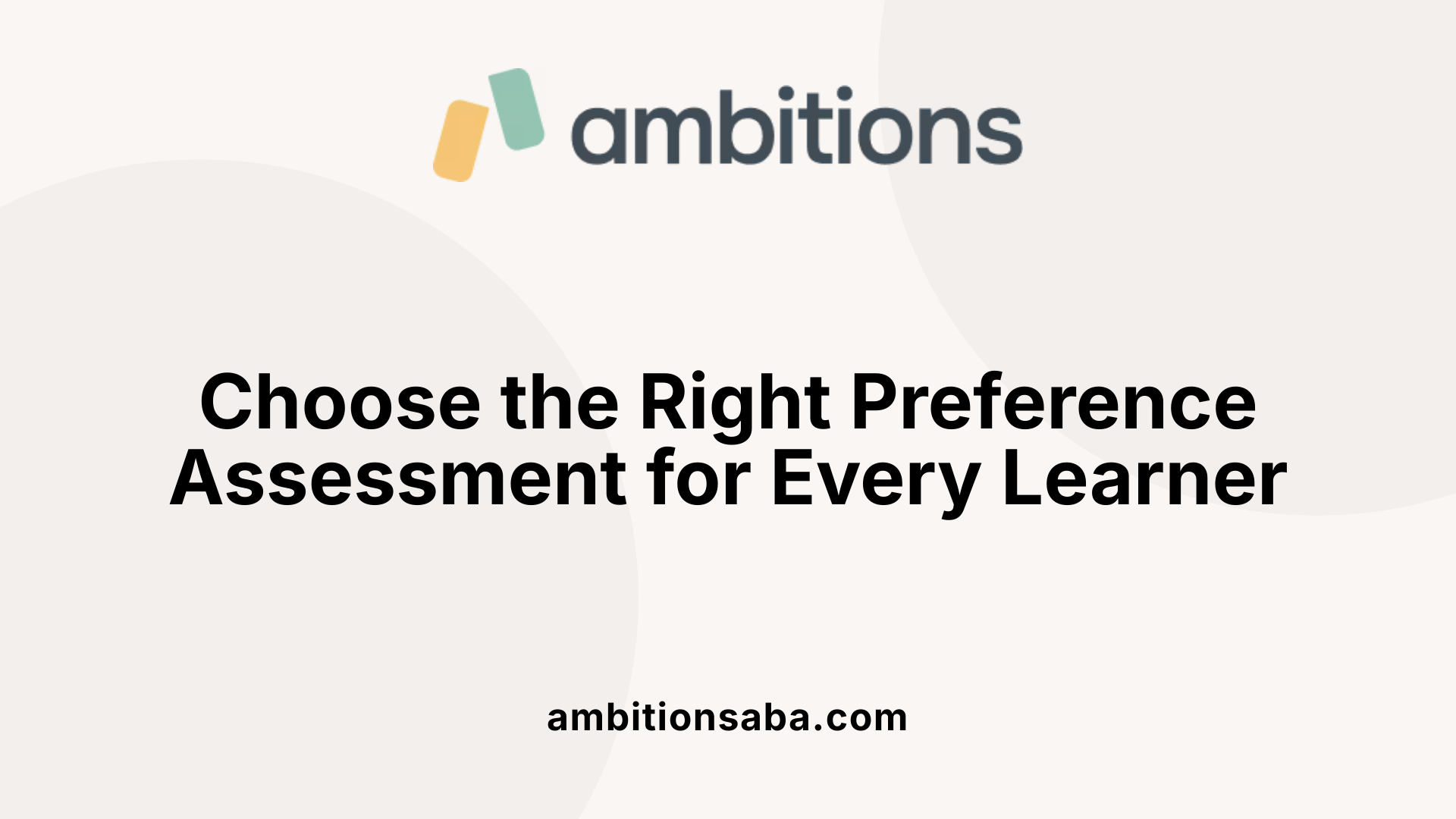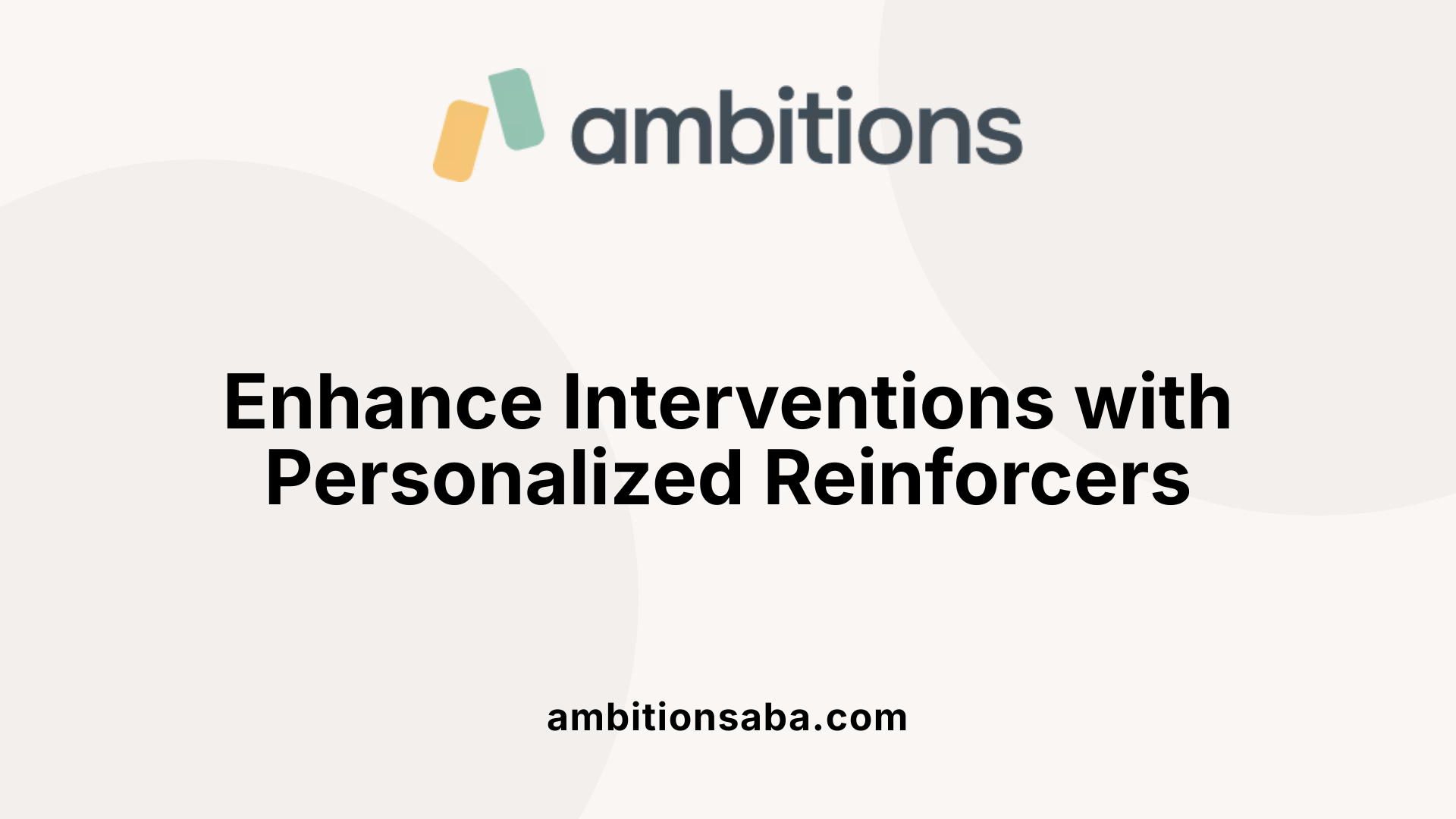Key Moments to Revise Behavior Intervention Plans for Maximum Effectiveness
Understanding the Foundation of Effective Reinforcement in ABA
Preference assessments are integral to applied behavior analysis (ABA), providing a structured approach to identify stimuli that motivate and reinforce desired behaviors. By systematically evaluating individual preferences, practitioners can personalize interventions, maintain motivation, and ensure ethical and effective reinforcement strategies. This article explores various types and methods of preference assessments, their practical implementation, and their vital role in creating impactful behavior intervention plans.
The Role and Significance of Preference Assessments in ABA

Why are preference assessments important for identifying effective reinforcers?
Preference assessments are crucial in ABA because they help identify what motivates an individual at a particular time. By using different methods such as multiple stimulus without replacement (MSWO) or paired stimulus choice tasks, practitioners can recognize which objects, activities, or stimuli an individual prefers most. These highly preferred items often serve as effective reinforcers that can strengthen desired behaviors. However, lower preference items may still function as reinforcers depending on the context and the person’s specific motivations. Since preferences can fluctuate, ongoing assessments ensure reinforcers stay relevant and motivating. Choosing appropriate reinforcers based on preference data not only makes interventions more ethical but also more likely to succeed in promoting learning and behavior change.
What is the role of preference assessments in ABA therapy?
In ABA therapy, preference assessments are used to identify individualized reinforcers that effectively motivate the client. They help predict which items or activities will increase the likelihood of desired behaviors by serving as reinforcing consequences. Various assessment methods—such as single stimulus, paired stimulus, or multiple stimulus formats—are used to gather this data by observing the individual’s responses to different stimuli. Conducting these assessments regularly ensures that the motivators remain relevant, especially when preferences change over time. The ultimate goal is to tailor interventions so that they are engaging, ethical, and personalized, fostering better learning outcomes.
How are preference assessments conducted in practice?
Practitioners typically conduct preference assessments by systematically presenting various stimuli and observing the individual’s reactions. Common methods include asking the individual directly, observing spontaneous choices during free operant sessions, or conducting trial-based assessments like paired stimulus, single stimulus, or multiple stimulus methods. The process involves compiling potential reinforcers, presenting them randomly to avoid side bias, and recording which items are selected, approached, or rejected. This data helps establish a hierarchy of preferences—from most to least preferred—guiding reinforcement choices. For edible items, assessments are often handled separately to adhere to safety and hygiene procedures, especially when medical or sensory sensitivities are involved.
What are the different types and methods of conducting preference assessments in ABA?
Preferences assessments encompass various techniques designed to identify motivating stimuli effectively. Common types include:
| Type | Description | Suitable For |
|---|---|---|
| Single stimulus | Presenting one item at a time and recording response | Beginners or when working with very young or non-verbal learners |
| Paired stimulus | Presenting two items simultaneously, noting which is chosen more often | When precise preference ranking is needed |
| Multiple stimulus with replacement (MSW) | Multiple items presented, with chosen items replaced, allowing repeated responses | When trying to quickly identify preferred items |
| Multiple stimulus without replacement (MSWO) | Items are presented sequentially, and chosen items are removed, establishing a preference hierarchy | For detailed preference ranking |
| Free operant | Observation of spontaneous engagement with freely available stimuli during downtime | When assessing natural preferences |
Each method has specific advantages and is selected based on the learner’s ability, the context, and the desired detail of preference data.
How do practitioners select appropriate preference assessments for individual learners?
Selection depends on the learner’s developmental level, ability to make choices, and the context of the assessment. For learners with limited communication skills or sensory sensitivities, simpler methods like single stimulus or free operant observations are preferred. More advanced learners may be suitable for paired stimulus or MSWO tasks that provide a clear hierarchy of preferences.
Practitioners also consider safety and hygiene, especially with edible stimuli. They evaluate the environment’s practicality, the reliability of responses, and the need for repeated assessments to accommodate changing preferences. Tailoring methods to the individual ensures accurate data and enhances the effectiveness of reinforcement strategies.
How can preference assessments be used to enhance behavior intervention plans?
Incorporating preference assessment results into behavior intervention plans ensures that reinforcers are meaningful and motivating. By identifying highly preferred stimuli, therapists can strategically use these as reinforcers to increase the likelihood of desired behaviors. Regular assessments help maintain the relevance of reinforcers as preferences evolve, preventing reinforcement from becoming ineffective. These assessments also aid in developing personalized, engaging interventions that promote successful skill acquisition, foster motivation, and accelerate progress towards goals.
In what ways do preference assessments aid decision-making in ABA practice?
Preference assessments provide empirical evidence to support reinforcement choices, guiding clinicians in selecting stimuli that will be most effective. The data from various assessment formats—such as MSWO or paired stimulus—help create a preference hierarchy that informs which reinforcers are worth using. Employing models like the SPADS decision-making framework further refines assessment selection based on stimulus features and client-specific factors. Regular assessments ensure that reinforcement strategies adapt to changing preferences, optimizing intervention outcomes and ensuring that ABA practice remains responsive and effective.
Can you explain the concept of preference assessment and its techniques?
A preference assessment is a systematic process to determine what objects, activities, or stimuli an individual prefers and finds motivating. Techniques include presenting stimuli one at a time (single stimulus), in pairs (paired stimulus), in multiple sets with or without replacement (MSW and MSWO), or observing spontaneous engagement during free operant sessions. These methods help identify which stimuli are most likely to serve as effective reinforcers. Indirect methods, like questionnaires, can supplement direct assessments but are less reliable. Ultimately, preference assessments inform the selection of personalized reinforcers, enabling more effective and engaging ABA interventions.
Selecting the Most Suitable Preference Assessment Method

How do practitioners select appropriate preference assessments for individual learners?
Practitioners choose suitable preference assessments by carefully considering the learner's developmental stage, communication skills, and specific needs. They evaluate factors such as whether the learner can make choices reliably, their sensory preferences, and the environment's safety. Methods like free operant observations, multiple stimulus assessments (MSWO), paired stimulus, or single stimulus presentations are selected based on these individual characteristics. Systematic data collection during these assessments helps identify what stimuli the learner prefers. Since preferences can change over time, frequent reassessment ensures reinforcement remains motivating, helping to strengthen desired behaviors.
What factors influence the choice of preference assessment methods, and how are assessments adapted to each learner?
Several factors guide the selection of a preference assessment. The learner’s age, cognitive ability, sensory sensitivities, and communication skills play significant roles. For example, learners with limited communication or motor skills may benefit from naturalistic observations where engagement is monitored without requiring active choice. In contrast, more capable learners can participate in paired stimulus or MSWO assessments that involve direct selecting between options.
Environmental conditions such as safety, hygiene, and sensory sensitivities are also crucial. When edible stimuli are involved, assessments are conducted separately, following hygienic protocols. Modifications like visual supports, simplified choices, or additional cues help tailor assessments, ensuring they are accessible and yield reliable results.
Why is it essential to consider the context and individual differences when choosing a preference assessment method?
The context and individual traits greatly influence which assessment method will be most effective. Preferences can vary depending on age, developmental level, and personal sensory preferences. For example, a child with severe motor impairments may show limited engagement during forced choice tasks but may reveal preferences during naturalistic observation.
Environmental safety and hygiene are also critical. Ethical considerations dictate that stimuli, especially edible items, are presented safely, with hygiene protocols adhered to. By customizing assessment methods to fit the individual and the setting, practitioners can accurately identify preferred stimuli, which serve as effective reinforcers. This tailored approach maximizes treatment outcomes and ensures the assessment process respects the learner’s dignity and safety.
| Factors Influencing Method Choice | Description | Additional Considerations |
|---|---|---|
| Developmental & Cognitive Level | Determines whether the learner can make active choices or needs observational methods | Use naturalistic or simplified methods for less capable learners |
| Sensory Sensitivities | Influences selection of stimuli and assessment environment | Avoid overstimulating stimuli or unsafe conditions |
| Environmental Safety & Hygiene | Ensures safe presentation of stimuli, especially edibles | Separate assessments with food or items requiring hygiene protocols |
| Communication Abilities | Guides whether direct choice or observation is appropriate | Use visuals or gestures to support expression |
| Feasibility & Reliability | Practical concerns regarding resources, timing, and data accuracy | Ensure methods are manageable within session constraints |
Practitioners must weigh these various factors to select the most appropriate, effective, and ethical assessment method tailored to each learner, promoting accurate identification of motivating stimuli and optimal reinforcement strategies.
Implementing Preference Assessments Effectively
What are the procedures for conducting preference assessments?
Preference assessments are systematic processes used by practitioners to identify stimuli that serve as effective reinforcers for an individual. The procedures involve presenting various items or activities and observing the learner’s responses to determine their preferences and establish a hierarchy.
Different methods are employed based on the learner’s abilities and the context. These include asking the individual directly, conducting free-operant observations where the learner interacts freely with available stimuli, and trial-based techniques such as paired stimuli, single stimulus, or multiple stimulus assessments. The choice of method depends on factors like communication skills, engagement level, and safety considerations.
Data collection is central to this process. Practitioners record responses such as which items are chosen, how long the learner engages, or outright rejection of stimuli. Sheila assessments with edible items are typically conducted separately from tactile or toy stimuli to maintain safety and hygiene.
The goal is to build a clear preference hierarchy, which helps in selecting potent reinforcers to shape desired behaviors. Repeated assessments are common to account for fluctuations in preferences caused by environmental changes or the learner’s developmental stage.
How do practitioners ensure reliability and safety during preference assessments?
Ensuring safety and reliability during preference assessments involves systematic planning and careful implementation. Practitioners follow structured procedures such as randomizing stimuli presentation to prevent side bias, timing the exposure of each stimulus consistently, and meticulously recording responses.
Hygienic procedures are emphasized, particularly when edible or potentially hazardous items are used. These include using clean utensils and changing materials between assessments to prevent contamination. When assessments involve edible items, they are often conducted in a separate session to minimize risks such as choking or allergic reactions.
Supervision is crucial at all times to promptly address any adverse reactions or safety concerns. Ongoing training for practitioners on safety guidelines and ethical standards helps sustain high-quality and safe assessment practices. Reliable data collection methods, such as inter-rater checks, further support the accuracy of preference hierarchies.
Why is it important to conduct frequent or repeated preference assessments?
Preferences can fluctuate due to age, recent experiences, environmental changes, or other factors. Conducting frequent or repeated assessments ensures that reinforcement strategies remain aligned with the individual’s current motivations. This practice helps maintain high levels of engagement and prevents stagnation, especially in dynamic populations like children with autism.
Repeated assessments can also reveal emerging interests or declining preferences for certain stimuli, enabling practitioners to adapt intervention plans promptly. For learners with rapidly changing preferences, more frequent evaluations help sustain motivation, increase learning opportunities, and improve the overall effectiveness of reinforcement strategies.
What adjustments might be necessary to accommodate individual differences and changing preferences during assessment?
Adjustments are essential to tailor preference assessments to individual needs, abilities, and sensory profiles. For learners with cognitive or communication limitations, modifications may include simplifying choices or increasing the duration of stimulus presentation.
Sensory sensitivities or medical issues may require using alternative stimuli, such as visual or tactile options, or conducting assessments on separate occasions when working with edibles to prevent adverse reactions.
Visual supports, prompts, or cues can facilitate choice-making for learners who have difficulty discriminating between stimuli. Additionally, increasing the frequency of assessments or using varied procedures helps capture evolving preferences, ensuring that reinforcement remains effective and ethically appropriate.
By customizing approaches to each individual, practitioners enhance the accuracy of preference hierarchies and promote sustained motivation.
| Aspect | Description | Additional Notes |
|---|---|---|
| Procedure Types | Asking, free operant, trial-based (paired, single, multiple) | Choice depends on individual's skills |
| Safety Measures | Hygiene, supervision, separate assessment for edibles | Critical to prevent hazards |
| Assessment Frequency | Regular, repeated assessments | Keeps reinforcers relevant |
| Adjustments | Stimulus modifications, visual supports, session timing | Supports individual differences |
This comprehensive approach ensures that preference assessments are both effective and safe, ultimately supporting better behavioral outcomes in ABA therapy.
Integrating Preference Assessments into Behavioral Interventions

How can preference assessments be used to enhance behavior intervention plans?
Preference assessments are essential tools in designing effective behavior intervention plans because they help identify what stimuli or activities are most motivating for an individual. By systematically determining a hierarchy of preferred items—whether through methods like Multiple Stimulus Without Replacement (MSWO), paired stimulus, or free operant observation—therapists can select reinforcers that are highly motivating.
Regular assessments ensure that reinforcers remain effective over time, especially since individual preferences can change. For instance, a toy or activity initially ranked as highly preferred might become less motivating later, so periodic reassessments keep reinforcement strategies personalized and current.
Using preferred stimuli as reinforcers increases motivation, boosts the frequency of desired behaviors, and promotes faster skill development. This personalized approach not only makes interventions more engaging but also more effective overall, leading to sustained improvements in Behavior.
In what ways do preference assessments improve decision-making and treatment planning?
Preference assessments provide empirical, individualized data that inform smarter decision-making in treatment planning. Rather than relying on assumptions, clinicians observe and record which stimuli the individual prefers, ensuring reinforcement strategies are tailored to their motivations.
This data-driven method increases the likelihood that reinforcers will be effective, which can reduce frustration and increase engagement in learning tasks. Tools like the Stimulus Preference and Assessment Decision Service (SPADS) aid practitioners in choosing the most appropriate assessment procedures, considering factors like the learner’s abilities and stimulus characteristics.
Implementing routine preference assessments helps identify emerging interests, adapt to changing preferences, and refine intervention strategies to maximize behavioral progress.
What benefits do regular preference assessments bring to behavior change and skill acquisition?
Regular assessment of preferences ensures that reinforcers remain relevant and motivating for the learner. This ongoing process helps prevent reinforcement satiation, maintaining high levels of engagement during interventions.
When reinforcement aligns with personal preferences, learners participate more actively in learning activities, which accelerates skill acquisition. Over time, this ongoing process supports long-term behavior change, skill generalization, and sustained motivation.
Besides, continuous updates from preference assessments reveal new or shifting interests, allowing practitioners to adapt interventions proactively, thus fostering a positive learning environment.
In what ways do preference assessments support ethical and effective ABA practices?
Preference assessments uphold ethical standards by personalizing reinforcement strategies based on the individual’s own preferences and choices. This respect for personal interests promotes dignity and dignity-centered interventions.
By systematically identifying preferred stimuli, practitioners can minimize or eliminate the need for punitive or aversive procedures, creating more humane treatment environments. These assessments offer objective, evidence-based data that guide ethical decision-making, ensuring that interventions are respectful, effective, and aligned with the individual’s motivations.
This practice supports the overarching goal of ABA to promote positive, meaningful change that honors the individual’s preferences.
What role does data play in the integration of preference assessments into ABA?
Data collection is fundamental in translating preference assessments into actionable treatment strategies. During assessments, data on which items are chosen, how long the learner engages with each, and which items are rejected provide a clear picture of preferences.
This empirical data supports decision-making by establishing reliable preference hierarchies, which guide reinforcer selection. Furthermore, ongoing data collection helps detect shifts in preferences over time, prompting necessary adjustments to intervention plans.
By integrating preference assessment data with continuous behavioral observations, practitioners can increase the effectiveness, ethicality, and personalization of ABA services, ultimately leading to more significant and lasting behavior change.
Bringing It All Together for Better Outcomes
Incorporating systematic preference assessments into ABA therapy is a cornerstone of ethical, effective, and personalized intervention. By employing various methods suited to individual needs and continuously updating preferences, practitioners can select highly motivating reinforcers that support sustained engagement and accelerated behavior change. Proper application of these assessments, combined with rigorous data analysis, ensures that reinforcement strategies are both effective and aligned with ethical standards. Ultimately, using preference assessments enhances the quality and personalization of ABA interventions, leading to better outcomes for learners and supporting their journey toward functional independence and improved quality of life.
References
- Types of Preference Assessments in ABA
- What Are Preference Assessments in ABA?
- Preference Assessments | EBIP
- Stimulus Preference Assessment Decision-Making System ...
- ABCs of ABA Preference Assessments
- Using Preference Assessments to Understand Motivation
- ON THE RELATION BETWEEN REINFORCER EFFICACY ...
- Preference Assessments | EBIP
- What Are Preference Assessments in ABA?

